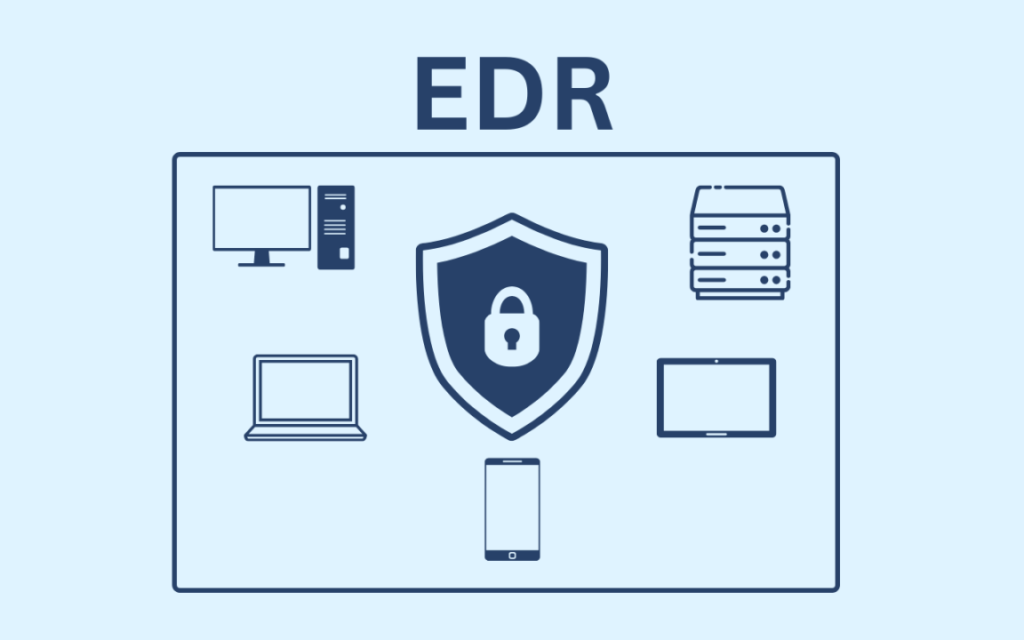Introduction to Endpoint Detection and Response (EDR)

In the rapidly evolving landscape of cybersecurity threats, Endpoint Detection and Response (EDR) has emerged as a critical component for safeguarding modern digital environments. Traditional antivirus solutions, while effective for basic threat detection, are increasingly inadequate in the face of sophisticated cyber-attacks. As cybercriminals deploy more advanced tactics, organizations must adopt more robust and dynamic security measures. This is where EDR tools come into play.
EDR solutions are designed to provide comprehensive protection by monitoring endpoint activities in real-time, detecting potential threats, and automating responses to mitigate damage. Endpoints, which include laptops, desktops, and mobile devices, are often the first line of defense against cyber intrusions. Given the rise of remote work and the proliferation of mobile devices, securing these endpoints has never been more crucial.
The evolution of cybersecurity threats has led to an increase in the complexity and frequency of attacks. Malware, ransomware, and phishing schemes are becoming more sophisticated, often bypassing traditional antivirus defenses. EDR tools address these challenges by continuously monitoring endpoint activities for unusual behavior, providing real-time threat detection, and enabling rapid response to neutralize threats. This proactive approach helps organizations to stay ahead of attackers, minimizing the impact of potential breaches.
Key features of EDR tools include advanced threat detection algorithms, real-time monitoring capabilities, and automated response mechanisms. These features enable security teams to identify and respond to threats more efficiently, reducing the window of opportunity for attackers. By leveraging machine learning and behavioral analysis, EDR solutions can detect anomalies that may indicate a compromise, ensuring that threats are addressed before they can cause significant harm.
In today’s interconnected work environment, protecting endpoints is paramount. EDR tools provide the necessary defense mechanisms to secure these critical assets, ensuring that organizations can operate safely and efficiently in the digital age. As cybersecurity threats continue to evolve, the adoption of EDR solutions will be essential for maintaining robust security postures and safeguarding sensitive information.
Key Features to Look for in EDR Tools
When evaluating Endpoint Detection and Response (EDR) tools, businesses need to consider several critical features to ensure robust security and operational efficiency. One of the foremost aspects is real-time threat detection. An effective EDR tool should swiftly identify and alert users about potential threats, minimizing the window for damage. This feature is crucial for maintaining the security posture of an organization in the face of ever-evolving cyber threats.
Behavioral analysis is another essential feature. This capability allows EDR tools to analyze patterns and behaviors to detect anomalies that may signify malicious activity. By understanding the typical behavior of users and systems, the tool can flag deviations that could indicate a security breach, even if the specific threat signature is unknown.
Automated response capabilities are indispensable for modern EDR solutions. These capabilities enable the tool to take predefined actions in response to detected threats, such as isolating affected devices or terminating malicious processes. Automation not only speeds up the response time but also reduces the burden on IT security teams, allowing them to focus on more strategic tasks.
Integration with other security systems is vital for a comprehensive defense strategy. EDR tools should seamlessly integrate with existing security information and event management (SIEM) systems, firewalls, and other cybersecurity infrastructure. This interoperability ensures a cohesive security environment, enhancing the overall effectiveness of the organization’s defenses.
User-friendliness and scalability are also critical considerations. An EDR tool should offer an intuitive interface that simplifies management and operation. Additionally, the solution must be scalable to accommodate growth, ensuring consistent protection as the organization expands. Support for various operating systems, including Windows, macOS, and Linux, is essential to safeguard all endpoints within a diverse IT environment.
Threat intelligence integration enhances the ability of EDR tools to recognize and respond to emerging threats. By leveraging up-to-date threat intelligence feeds, the tool can identify new attack vectors and techniques, providing timely defenses against novel threats.
Incorporating machine learning capabilities allows EDR tools to improve over time by learning from previous incidents and refining their detection algorithms. This adaptive approach helps in identifying sophisticated threats that traditional, signature-based methods might miss.
Lastly, comprehensive reporting and analytics are crucial for maintaining situational awareness and compliance. EDR tools should provide detailed logs and reports that offer insights into detected threats, response actions, and overall security posture. These features are invaluable for both operational monitoring and strategic decision-making, ensuring that the organization remains resilient against cyber threats.
Top EDR Tools for 2024: A Comprehensive Review
As organizations continue to prioritize cybersecurity, selecting the right Endpoint Detection and Response (EDR) tool is crucial. In 2024, several EDR solutions stand out for their robust features, user-friendly interfaces, and industry recognition. Below, we delve into the highlights and considerations of the leading EDR tools.
CrowdStrike Falcon
Vendor: CrowdStrike
Key Features: Real-time threat intelligence, AI-powered analytics, and advanced threat hunting capabilities.
Pricing: Subscription-based, with tiers catering to different organizational sizes.
Target Audience: Enterprises and mid-sized businesses.
Strengths: CrowdStrike Falcon is widely lauded for its comprehensive threat detection and response capabilities, bolstered by a cloud-native architecture that ensures minimal performance impact on endpoints. The platform’s integration with threat intelligence feeds enhances its proactive defense mechanisms.
Weaknesses: Some users have reported that the initial setup can be complex and resource-intensive. Additionally, the cost may be prohibitive for smaller businesses.
Customer Feedback: Users appreciate the tool’s efficiency and the depth of its threat analysis. CrowdStrike Falcon consistently receives high ratings in industry reviews.
SentinelOne
Vendor: SentinelOne
Key Features: Autonomous detection and response, machine learning algorithms, and rollback capabilities.
Pricing: Flexible pricing models, including per-endpoint options.
Target Audience: Small to large enterprises.
Strengths: SentinelOne excels in its autonomous operation, offering real-time remediation and rollback features that allow systems to recover quickly from attacks. Its machine learning models continually adapt to emerging threats.
Weaknesses: While highly effective, some users find its interface less intuitive compared to competitors. The learning curve may be steep for less experienced IT teams.
Customer Feedback: SentinelOne is praised for its proactive defense and swift response times. Industry ratings reflect strong user satisfaction.
Carbon Black
Vendor: VMware
Key Features: Comprehensive endpoint visibility, cloud-based analytics, and custom threat detection rules.
Pricing: Subscription-based, with various packages available.
Target Audience: Enterprises and security-focused organizations.
Strengths: Carbon Black’s strength lies in its deep visibility into endpoint activities, supported by robust analytics and customizable detection rules. The platform’s integration with VMware’s ecosystem is a significant advantage for organizations using VMware solutions.
Weaknesses: Some users have noted that the platform can generate a high number of alerts, which may require additional resources to manage effectively.
Customer Feedback: Users value the detailed insight and control Carbon Black offers. It garners favorable reviews for its integration capabilities and thorough threat detection.
Microsoft Defender for Endpoint
Vendor: Microsoft
Key Features: Built-in threat and vulnerability management, automated investigation, and response, extensive integration with Microsoft 365.
Pricing: Available as part of Microsoft 365 E5 or standalone licenses.
Target Audience: Organizations using Microsoft’s ecosystem.
Strengths: Microsoft Defender for Endpoint benefits from seamless integration with other Microsoft products, making it an attractive option for organizations already invested in the Microsoft ecosystem. Its automated investigation and response capabilities streamline threat management.
Weaknesses: While highly effective within its ecosystem, it may be less suitable for organizations using diverse IT environments. Additionally, the platform’s extensive features can be overwhelming for smaller teams.
Customer Feedback: Users appreciate its integration and automation capabilities, with many noting the ease of use for organizations heavily utilizing Microsoft products. It maintains strong ratings in user reviews.
In conclusion, the choice of an EDR tool depends on specific organizational needs, existing IT infrastructure, and budget constraints. Each of these tools offers distinct advantages and potential limitations. Careful evaluation and alignment with organizational priorities will ensure the optimal selection of an EDR solution for 2024.
Choosing the Right EDR Tool for Your Organization
Selecting the most suitable Endpoint Detection and Response (EDR) tool for your organization is a critical decision that requires careful consideration of multiple factors. The size of your organization is a key determinant; smaller businesses may have different needs compared to larger enterprises. For instance, a smaller company might prioritize ease of use and quick deployment, whereas a larger organization might require advanced features and scalability.
Industry-specific requirements also play a significant role in this decision-making process. Certain industries, such as healthcare or finance, have stringent regulatory requirements that mandate specific security features. It is essential to choose an EDR tool that complies with industry standards and provides features tailored to your sector.
Budget constraints cannot be overlooked. While it may be tempting to opt for the most cost-effective solution, it is crucial to balance cost with functionality. Evaluate the total cost of ownership, which includes not only the initial purchase price but also ongoing costs such as maintenance, updates, and support. A more expensive tool may offer better long-term value if it includes comprehensive support and updates.
Existing security infrastructure should also be considered. The chosen EDR tool should integrate seamlessly with your current systems to ensure a cohesive security strategy. Compatibility with existing software and hardware can prevent disruptions and reduce the learning curve for your IT team.
A step-by-step evaluation process can aid in making an informed decision. Start by identifying your organization’s specific needs and constraints. Conduct trials of shortlisted EDR tools to assess their performance and suitability. Seek opinions from industry experts and consult reviews to gauge the general consensus on various tools. Additionally, consider the vendor’s reputation for providing ongoing support and training. Effective implementation and utilization of the EDR tool hinge on the availability of continuous assistance and educational resources.
By thoroughly evaluating these factors, organizations can select an EDR tool that not only meets their immediate needs but also supports long-term security objectives.

